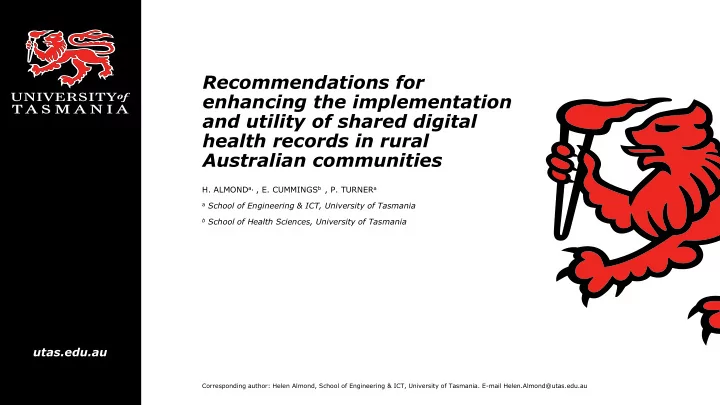

Recommendations for enhancing the implementation and utility of shared digital health records in rural Australian communities H. ALMOND a, , E. CUMMINGS b , P. TURNER a a School of Engineering & ICT, University of Tasmania b School of Health Sciences, University of Tasmania utas.edu.au Corresponding author: Helen Almond, School of Engineering & ICT, University of Tasmania. E-mail Helen.Almond@utas.edu.au
Plan Introduction Method Results Recommendations Conclusion
Introduction The question is not whether people with CCC’s An evaluation of the manage their illnesses but how they manage experience of people living Vulnerable (Bodenheimer et.al. 2002, p 2469 – with CCCs in a rural and 2475). health care remote community and their engagement with shared users digital health care provision. [T]hat partners seek to achieve through collaboration is more than a mere exchange of Participatory resources. By combining the Shared individual perspectives, research resources, and skills of the digital health The idea is that something has partners, the group creates evaluation been delivered, it has got some something new and valuable records great potential but it needs to together — something that is methods be made more useful, usable greater than the sum of its and safe (Coiera et.al. 2012, p 430- parts’ (Lasker, Weiss & Miller 2001, 431). p. 184).
Methodology Axiology Practical knowing ‘what is Method essentially worth while’ CBPR principles Social participation Epistemology ( Extended ) Cooperation Systematic and planned Experiential knowing Collaboration Relevant to the community Presentational knowing Community involvement Propositional knowing Problem solving focus Practical knowing Focus on societal change About sustainability Paradigm Design Qualitative Research techniques & Ontology ( Subjective ) tools for data collection Participatory and analysis
Recruitment
Method – The research design Data Collection Phase 1. Phase 2. Phase 3. • 3 local • 19 SSIs • 19 SSIs Post- meetings • 3 local • 3 local Registration Pre- experience and early • 19 SSIs meetings meetings experience and engagement engagement of MyHR • Reflective with MyHR • Reflective • Reflective with MyHR diary journal Journal Data Analysis Phase 3. Phase 2. Phase 1. Familiarisation Indexing & Development Data Data Data charting Interpretation of initial description explanation management thematic frame Mapping work
Results
Discussion - Tailored facilitation . If there was a computer day … I should have a go, my grandchildren was going to teach me. If there was an opportunity … a buddy system …. My younger sister could teach me (CH21)
Discussion - Resilience I know my body and how they [CCCs] affect me. It may not be what’s written in the books but I need to communicate that … . It’s me, my body I know what’s really going on. I think a lot of people are going to the Drs and following what they say without question. What happens if that doesn’t work for me or makes me bad? I need a two way street. (CH23)
25. Discussion – Reflection Reflection is an evaluation of the benefits and challenges of using a participatory paradigm to engage vulnerable healthcare users in research, while they are also becoming adopters of digital health tools.
Answering the research question 1. What is the experience of MyHR for people living with CCCs in a rural community? 2. Why do people with complex chronic conditions, living in a rural community engage with MyHR?
Recommendations Australia launched its SDHR in 2012 yet it remains without a personally or contextually significant framework or resources However, when supported… …MyHR is viewed by the c ommunity as an ‘ ess ssential al heal alth th car are reso source ’ …the community learned to take responsibility both as individuals and as a groups for their engagement with MyHR In turn this condones the continued delivery of health care provision that marginalises and undervalues the capacity of vulnerable healthcare users to obtain benefit from digital health tools
30. Conclusion The research proposes that the person, community, healthcare provider, and educational institutions should view MyHR as an essential adjunct to quality healthcare provision , viewed as person centred care from a complex adaptive system perspective, and accepted as a contemporary model of quality digital healthcare provision.
Recommend
More recommend